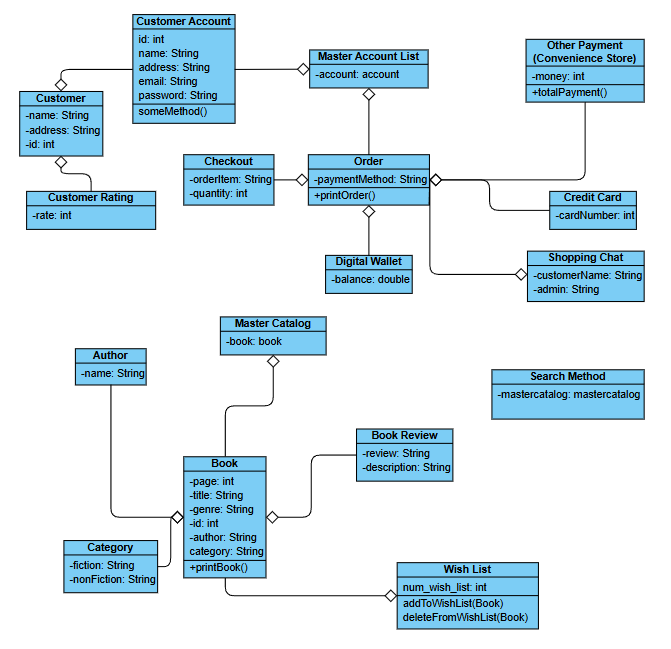Introduction
A class diagram is a static UML (Unified Modeling Language) diagram that models the structure of a system by representing its classes, attributes, methods, and relationships. The provided diagram illustrates an e-commerce system for managing customer accounts, orders, books, and related entities. This tutorial will dissect the diagram, explain key concepts, provide multiple class diagram examples, and offer tips and tricks to create clear and functional class diagrams.
Part 1: Understanding the E-Commerce System Class Diagram
Overview of the Diagram

The diagram represents an e-commerce system with the following key entities:
- Customer: Represents a user with account details.
- Customer Account: A detailed account linked to a customer.
- Customer Rating: Tracks customer ratings.
- Master Account List: Manages multiple customer accounts.
- Checkout: Handles the checkout process for orders.
- Order: Represents a customer’s order with payment details.
- Credit Card: Stores payment information.
- Digital Wallet: Another payment method.
- Shopping Chat: Facilitates customer support.
- Author: Represents book authors.
- Category: Classifies books (fiction/non-fiction).
- Book: The core product with details like title and genre.
- Master Catalog: Manages the book catalog.
- Book Review: Stores reviews for books.
- Wish List: Allows customers to save desired books.
- Search Method: Provides search functionality.
Relationships in the Diagram
- Association:
- Customer is linked to Customer Account and Customer Rating.
- Customer Account is part of Master Account List.
- Checkout is associated with Order.
- Order uses Credit Card or Digital Wallet for payment.
- Book is linked to Author, Category, Book Review, and Wish List.
- Aggregation:
- Master Catalog aggregates Book (open diamond arrow).
- Dependency:
- Search Method depends on Master Catalog.
- Multiplicity:
- 1 (one-to-one, e.g., one Customer to one Customer Account).
- * (zero or more, e.g., many Order instances per Checkout).
Part 2: Key Concepts of Class Diagrams
Core Components
- Class:
- A rectangle with three sections: class name, attributes, and methods.
- Example: Book with attributes -page: int, -title: String, and method +printBook().
- Attributes:
- Data fields within a class, prefixed with visibility (+ public, – private).
- Example: -cardNumber: int in Credit Card.
- Methods:
- Operations or behaviors of a class, also with visibility.
- Example: +totalPayment() in Master Account List.
- Relationships:
- Association: A general connection between classes (e.g., Customer to Order).
- Aggregation: A “whole-part” relationship where parts can exist independently (e.g., Master Catalog and Book).
- Composition: A strong “whole-part” relationship (not explicitly shown here but implied in some cases).
- Dependency: One class depends on another (e.g., Search Method on Master Catalog).
- Inheritance: Not shown in this diagram but common in UML (e.g., a subclass of Customer).
- Multiplicity:
- Defines the number of instances (e.g., 1 for one, * for many).
- Example: Customer Account to Master Account List (one-to-many implied).
Key Principles
- Abstraction: Focus on essential elements, omitting minor details.
- Encapsulation: Use visibility to control access to attributes and methods.
- Modularity: Divide the system into reusable classes.
- Consistency: Maintain uniform naming and formatting.
Part 3: Guidelines for Creating Effective Class Diagrams
- Identify Entities:
- List all key objects (e.g., Customer, Book, Order).
- Define Attributes and Methods:
- Include only relevant data and behaviors.
- Map Relationships:
- Use appropriate connectors (e.g., lines for association, diamonds for aggregation).
- Use Multiplicity:
- Specify how many instances are involved (e.g., 1..* for one or more).
- Keep It Simple:
- Avoid overcrowding; use multiple diagrams if necessary.
- Validate:
- Ensure the diagram reflects the system’s logic and is understandable to others.
Part 4: Class Diagram Examples
Below are multiple class diagram examples inspired by the e-commerce system, ranging from simple to complex.
Example 1: Basic Customer and Account Relationship

- Explanation:
- A Customer has one CustomerAccount (1-to-1 association).
Example 2: Master Account List and Customer Accounts

- Explanation:
- MasterAccountList manages one or more CustomerAccount instances (1-to-many).
Example 3: Order and Payment Methods
- Explanation:
- An Order can use either a CreditCard or DigitalWallet (1-to-1 association).
Example 4: Book and Related Entities
- Explanation:
- An Author writes one or more Book instances.
- A Category classifies one or more Book instances.
Example 5: Master Catalog and Book Review

- Explanation:
- MasterCatalog aggregates one or more Book instances (aggregation with o–>).
- A Book can have zero or more BookReview instances.
Example 6: Complete E-Commerce System

- Explanation:
- This mirrors the original diagram, including all entities and relationships.
- Uses association, aggregation (o–>), and dependency (..>).
Conclusion
Class diagrams are essential for modeling the structure of systems like the e-commerce platform shown in the diagram. By mastering key concepts such as associations, aggregations, and multiplicities, and following guidelines for clarity, you can create effective diagrams. The class diagram examples provided range from simple relationships to a complete system model, demonstrating practical applications. With the tips and tricks outlined, you can enhance your diagramming skills and collaborate efficiently on system design.
This tutorial provides a thorough foundation for creating class diagrams based on the e-commerce system. Let me know if you’d like more examples or advanced techniques!